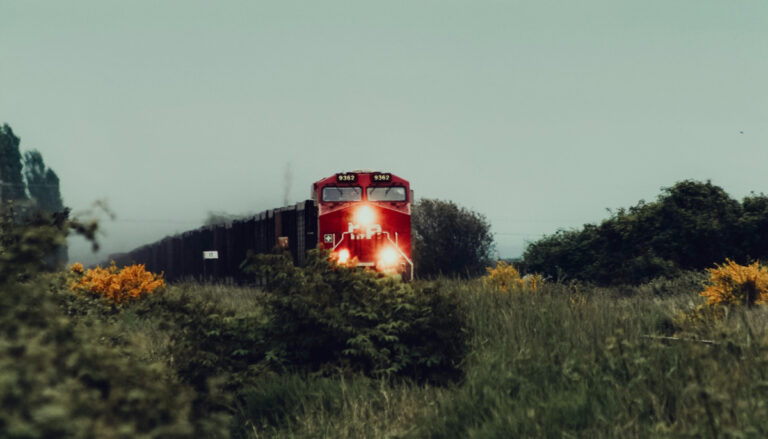Hitchhiking on steroids: inside the reckless TikTok train hopping trend

Some use Uber to get from a to b, other’s Lyft. Noah gauges the speed of 15,000-tonne cargo train containers before throwing himself in between the carriages. If he’s correct, he boards the cargo train. If he’s wrong, he is crushed beneath the steel wheels to almost certain and excruciating death. He’s directionless, at the mercy of the tracks. He has just a vague idea of where his destination is; the train driver (or fate) will decide the rest. It’s essentially hitchhiking on steroids.
“That’s the fun of it though,” Noah said over a brief and anonymous conversation, “you never quite know where the train will take you.” Of course, Noah isn’t his real name, taking up the train hopper life is highly illegal for a reason—with optimism, it’s a naive and miscalculated risky gamble, realistically it’s pretty stupid.
But Noah isn’t the first person willing to dice with death through train hopping, and he won’t be the last either. Ever since trains have chugged, people have caught free rides—it’s a tradition that has spanned generations. During the Great Depression of the 1930s, an estimated quarter of a million people travelled illegally on freight trains looking for jobs. It’s an era of history that spawned the term ‘hobo’, coming from the slang ‘hoe boys’ as a way to label migratory farmworkers.
I discovered the concept of train hopping (at least the modern alternation) not from history books but from YouTube. During one of my routine, procrastination-driven late-night YouTube binges, I stumbled across a man who goes by the name Brave Dave. His series, titled ‘Brave Dave’s Big Fat Freight Hop’ consisted of a multiple-hour freight-hopping journey across Canada, avoiding security and sleeping in ditches. The minimalist editing and early 2010s GoPro video quality are symbolic of his journey across the country itself—dirty, rugged and rough around the edges.
The problematic rise of the train hopping TikTok trend
Video quality has raised since then, and so has the bar of which clout-chasers will go for those precious likes. It’s no surprise then that the action, once used by migrant farmworkers to desperately escape economic depravity, has been whitewashed by gen Z TikTokers.
@coolrockerchick #jugallos #latfo #trainriding #trainhopping #hotgirlsummer #ooglettes
♬ What is a Juggalo? - Insane Clown Posse
Queue a video showing a majority white group of Gen Z Americans drinking vodka on a moving cargo train to ‘What Is A Juggalo?’ by Insane Clown Posse. Admittedly, this tops as the most cringe-inducing post on the train hopping hashtag on TikTok, a trend that is currently ranking at 33 million views, but it goes to prove a point.
“Not only does this paint our community in a shitty and reckless way—it’s also just stupid. Why the hell would you drink while train hopping? It’s dangerous enough being sober,” Noah accounts, describing his last US inter-state train hopping journey. “I at least took it seriously and analysed the risks involved.”
But even the videos which are significantly less cringe-inducing pose a threat to society. TikTok has the youngest consumer base and so, consequently, the most impressionable too. Worse still, TikTok and other social media platforms lack the descriptive information needed to train hop safely and, in essence, not die.
Prior to social media, those willing to start their own train hopping journey would resort to Reddit or obscure online forums to get their tips. Posting this sort of content via the video-sharing app not only gives the false impression that it’s safe to hop onto a moving train but that it’s actually glamorous to do so. You’re not robbing a car, you’re hopping a train—so please, for your own sake, don’t dub it with a GTA San Andreas soundtrack.
Why do people hop trains in the first place?
For Noah, it’s about “the freedom.” The idea of living life completely on the road (or tracks) with every day different to the last. And I get it, in some respects at least: the idea of escaping the mundane and repetitive metropolitan routine is fairly tempting. But can’t you just hitchhike instead? Noah replies, “It’s more about the thrill and adrenaline than anything. It’s about pushing your body and your mind to its limit. It’s definitely a thing to do out of leisure.”
But the TikToks posted by content creators glamorising train hopping are either unaware or don’t care about the consequence of their actions. “These people don’t respect a subculture of society which has been passed down for generations—they’re only in it for the views,” Noah argues.
The consequence is, sadly, reflected in the numbers. In the year 2018, railroad trespassing fatalities in the US hit a ten-year record high. “Let’s face it. Compared to any other form of travelling, train hopping is easily the most dangerous,” Reddit user Huckstar posted on r/vagabond, a subreddit dedicated to connecting an online community of hitchhikers, squatters, train hoppers and backpackers. “Sure, hitchhiking is definitely a roll of the dice each and every time, but it’s nothing compared to jumping on a moving piece of metal on steel weighing 15,000 tons,” they continued.
I value my 99p Chicken Mayos too much to risk my life on the rails. However, I respect that everyone’s values are different and so, if you do wish to live the hobo life, I can only provide you with the statistics—which, coincidentally, indicates it’s a reckless idea. Yet if, in spite of all evidence, you’re still committed, do your research, and for the love of God (and your dignity), don’t post it on TikTok.





